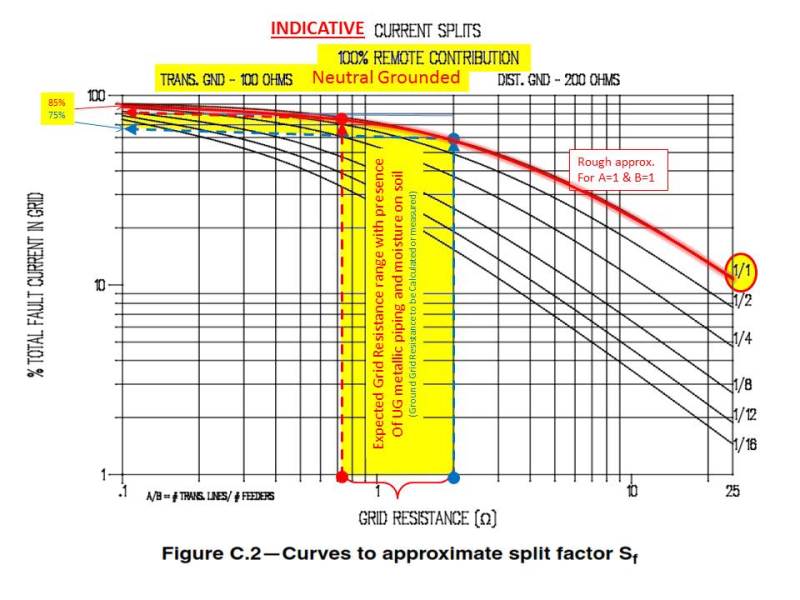Here is something you might want to try as a sanity check for your calculations:
I use WinIGS software for grounding analysis.
It is quite powerful.
A very limited (compared to WinIGS, not to other short circuit programs) but free related program which is kind of a mini-version is available.
Search for "GEMI conduit" and you will find several links to the "GEMI" program. It runs on Windows or Linux using WINE.
The intended purpose of GEMI is analysis of wire or cables in steel conduit and program development apparently was funded by folks who want us to specify steel conduit.
With me, it achieved its intended purpose, I'm giving a lot more thought into EMI issues with cabling now, no more PVC everywhere because it's cheap and I am using more steel these days.
But GEMI can do a bit more than analyze cables in conduits. It doesn't do ground grids, but it will calculate the current in a conduit and/or a neutral or the static wire on a transmission line plus the currents into earth for a multi-grounded wye line if you have already otherwise calculated the ground grid and ground rod resistances. Available line models are quite limited compared to WinIGS and you can't modify the models but you may find something in the program that is reasonably close to your situation.
A minor learning curve is involved since the program does a lot more than a typical symmetrical components based short circuit program with the neutral/ground "Kron reduced" out of the matrix.
You will need information on the source feeder, if and how it is grounded, # of grounds/mile, and so on.
It can be hard (actually impossible) to get this info from your friendly local utility and this is where GoogleEarth with its measuring capabilities can be put to good use. Span lengths should be adjusted from actual if there isn't a ground at every pole, and there usually isn't, usually just those with transformers. If there are customer service grounds along the line you can add an estimate of these, but they may be unreliable since I doubt most electricians actually take a reading to see if the second ground rod is needed... If you can measure any ground rods or other electrodes at your facility with a clamp-on tester and reverse engineer the ground rod calculation to get an estimate of rho in your area. If you have a Megger DET/2 or similar so much the better.
With regards to the program I have uploaded a sample file with a multi-grounded 12kV line. You want to select "Network Analysis" then load the file. Select "Network Analysis" and put a L-G fault at Bus 2. Then use "Network Reports" to see all of the current flows for the fault. It is a bit messy but that is because there is so much information. Change the 1Mohm ground that I placed on the primary star point of the ungrounded wye - delta bank to 1 ohm or thereabouts and re-run the fault to see current into earth at the load end of the distribution line and at the source. You will find that with good grounds at both ends of a relatively short line the 25 ohm pole (assumed) grounds don't do a lot.
Dr. Meliopoulos may have given away a bit more of the store than he intended with this little GEMI program, or maybe not. A few hours spent with GEMI may make you really want to buy a WinIGS license.
Definitely (always) cross-check this or any other program with your manual calculations or other methods. In my experience with WinIGS actual GPRs are less than estimated by the manual calculation methods which is reasonable since manual calculations are intended to be conservative.
I think this use of the GEMI program is within the license provisions but follow your own conclusions on this point. Since I have WinIGS I have used GEMI just for small problems needing a quick answer when I am away from the office computer or of course for conduit design.
Hope this helps.
One more thing, do try out out the conduit analysis tools and check out the research literature on the benefits of steel. If you include a steel conduit in a network simulation expect to wait a while for the answer. It's a non-linear problem, lots of number crunching.

